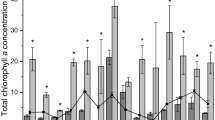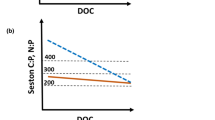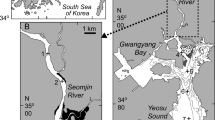Abstract
The use of nutrients by diverse phytoplankton communities in estuarine systems, and their response to changes in physical and biogeochemical processes in these natural systems, is a significant ongoing area of research. We used a whole ecosystem 15NO3− tracer experiment to determine the uptake of different nitrogen (N) forms in phytoplankton functional groups over a mid- to neap tidal cycle in a salt marsh creek in Plum Island Estuary, Massachusetts, USA. We quantified the biomass and δ15N for three groups corresponding to micro- (20–200 μm; microP), nano- (3–20 μm; nanoP), and picophytoplankton (< 3 μm; picoP). All three size classes showed distinct use of recycled N sources throughout the 11-day sampling period and minimal direct assimilation of the 15NO3− tracer. MicroP consistently used high amounts of creek-derived 15NH4+, even with a shift at neap tide from diatom- to dinoflagellate-dominated communities (including members of the harmful genus Alexandrium). NanoP use of recycled 15NH4+ increased over the mid-neap tidal cycle, while picoP use decreased. Both biomass and NH4+ use (as highest δ15N values) of all size groups were maximized during neap tide. This study demonstrates partitioning of recycled N use among size-based phytoplankton groups in the estuary, with distinct effects of tidal cycle on the nutrient uptake of each group, and with important implications for the roles of diverse phytoplankton communities in estuarine nutrient cycling.








Similar content being viewed by others
References
Affe, H.M.J., J. Rigonato, J.M.C. Nunes, and M. Menezes. 2018. Metagenomic analysis of cyanobacteria in an oligotrophic tropical estuary, South Atlantic. Frontiers in Microbiology 9: 1393. https://doi.org/10.3389/fmicb.2018.01393.
Anderson, D.M., B.A. Keafer, W.R. Geyer, R.P. Signell, and T.C. Loder. 2005. Toxic Alexandrium blooms in the western Gulf of Maine: The plume advection hypothesis revisited. Limnology and Oceanography 50 (1): 328–345.
Balch, W.M. 1981. An apparent lunar tidal cycle of phytoplankton blooming and community succession in the Gulf of Maine. Journal of Experimental Marine Biology and Ecology 55 (1): 65–77.
Berthelot, H., S. Duhamel, S. L’Helguen, J.-F. Maguer, S. Wang, I. Cetinić, and N. Cassar. 2019. NanoSIMS single cell analyses reveal the contrasting nitrogen sources for small phytoplankton. The ISME Journal 13 (3): 651–662.
Blauw, A.N., E. Benincà, R.W.P.M. Laane, N. Greenwood, and J. Huisman. 2012. Dancing with the tides: Fluctuations of coastal phytoplankton orchestrated by different oscillatory modes of the tidal cycle. PLoS One 7 (11): e49319. https://doi.org/10.1371/journal.pone.0049319.
Bronk, D.A., J.H. See, P. Bradley, and L. Killberg. 2007. DON as a source of bioavailable nitrogen for phytoplankton. Biogeosciences 4 (3): 283–296.
Cadier, M., T. Gorgues, S. L’Helguen, M. Sourisseau, and L. Memery. 2017. Tidal cycle control of biogeochemical and ecological properties of a macrotidal ecosystem. Geophysical Research Letters 44 (16): 8453–8462.
Capriulo, G.M., G. Smith, R. Troy, G.H. Wikfors, J. Pellet, and C. Yarish. 2002. The planktonic food web structure of a temperate zone estuary, and its alteration due to eutrophication. Hydrobiologia 475 (476): 263–333.
Carpenter, E.J., and S. Dunham. 1985. Nitrogenous nutrient uptake, primary production, and species composition of phytoplankton in the Carmans River estuary, Long Island, New York. Limnology and Oceanography 30 (3): 513–526.
Childers, D.L. 1994. Fifteen years of marsh flumes: A review of marsh-water column interactions in Southeastern USA estuaries. In Global Wetlands: Old World and New, ed. W.J. Mitsch, 277–294. New York: Elsevier Ltd.
Cloern, J.E. 1991. Tidal stirring and phytoplankton bloom dynamics in an estuary. Journal of Marine Research 49 (1): 203–221.
Cloern, J.E., S.Q. Foster, and A.E. Kleckner. 2014. Phytoplankton primary production in the world’s estuarine-coastal ecosystems. Biogeosciences 11 (9): 2477–2501.
Collos, Y., C. Gagne, M. Laabir, A. Vaquer, P. Cecchi, and P. Souchu. 2004. Nitrogenous nutrition of Alexandrium catanella (Dinophyceae) in cultures and in Thau Lagoon, Southern France. Journal of Phycology 40 (1): 96–103.
Davidson, K., R.J. Gowen, P. Tett, E. Bresnan, P.J. Harrison, A. McKinney, S. Milligan, D.K. Mills, J. Silke, and A. Crooks. 2012. Harmful algal blooms: How strong is the evidence that nutrient ratios and forms influence their occurrence? Estuarine, Coastal and Shelf Science 115: 399–413.
Deegan, L.A., and R.H. Garritt. 1997. Evidence for spatial variability in estuarine food webs. Marine Ecology Progress Series 147: 31–47.
Deegan, L.A., J.L. Bowen, D. Drake, J.W. Fleeger, C.T. Friedrichs, K.A. Galván, J.E. Hobbie, C. Hopkinson, D.S. Johnson, J.M. Johnson, L.E. LeMay, E. Miller, B.J. Peterson, C. Picard, S. Sheldon, M. Sutherland, J. Vallino, and R.S. Warren. 2007. Susceptibility of salt marshes to nutrient enrichment and predator removal. Ecological Applications 17 (sp5): S42–S63.
Dortch, Q. 1990. The interaction between ammonium and nitrate uptake in phytoplankton. Marine Ecology Progress Series 61: 183–201.
Drake, D.C., B.J. Peterson, K.A. Galván, L.A. Deegan, C. Hopkinson, J.M. Johnson, K. Koop-Jakobsen, L.E. LeMay, and C. Picard. 2009. Salt marsh ecosystem biogeochemical responses to nutrient enrichment: A paired 15N tracer study. Ecology 90 (9): 2535–2546.
Duernberger, K., C. Tobias, and M.A. Mallin. 2011. Tracing nitrogen transformations through the food chain in an urbanized tidal creek. Water Resources Research Institute, University of North Carolina, Report 405.
Dugdale, R.C., F.P. Wilkerson, V.E. Hogue, and A. Marchi. 2007. The role of ammonium and nitrate in spring bloom development in San Francisco Bay. Estuarine, Coastal and Shelf Science 73 (1-2): 17–29.
Fauchot, J., M. Levasseur, and S. Roy. 2005. Daytime and nighttime vertical migrations of Alexandrium tamarense in the St. Lawrence Estuary (Canada). Marine Ecology Progress Series 296: 241–250.
Fouilland, E., M. Gosselin, R.B. Rivkin, C. Vasseur, and B. Mostajir. 2007. Nitrogen uptake by heterotrophic bacteria and phytoplankton in Arctic surface waters. Journal of Plankton Research 29 (4): 369–376.
Giblin, A., C. Tobias, B. Song, N. Weston, G.T. Banta, and V.H. Rivera-Monroy. 2013. The importance of dissimilatory nitrate reduction to ammonium (DNRA) in the nitrogen cycle of coastal ecosystems. Oceanography 26 (3): 124–131.
Glibert, P.M. 2016. Margalef revisited: A new phytoplankton mandala incorporating twelve dimensions, including nutritional physiology. Harmful Algae 55: 25–30.
Glibert, P.M., F.P. Wilkerson, R.C. Dugdale, J.A. Raven, C.L. Dupont, P.R. Leavitt, A.E. Parker, J.M. Burkholder, and T.M. Kana. 2016. Pluses and minuses of ammonium and nitrate uptake and assimilation by phytoplankton and implications for productivity and community composition, with emphasis on nitrogen-enriched conditions. Limnology and Oceanography 61 (1): 165–197.
Harrison, W.G., and L.J.E. Wood. 1988. Inorganic nitrogen uptake by marine picoplankton: Evidence for size partitioning. Limnology and Oceanography 33 (3): 468–475.
Hattenrath, T.K., D.M. Anderson, and C.J. Gobler. 2010. The influence of anthropogenic nitrogen loading and meteorological conditions in the dynamics and toxicity of Alexandrium fundyense blooms in a New York (USA) estuary. Harmful Algae 9 (4): 402–412.
Holmboe, N., H.S. Jensen, and F.Ø. Andersen. 1999. Nutrient addition bioassays as indicators of nutrient limitation of phytoplankton in an eutrophic estuary. Marine Ecology Progress Series 186: 95–104.
Holmes, R.M., J.W. McClelland, D.M. Sigman, B. Fry, and B.J. Peterson. 1998. Measuring 15N-NH4+ in marine, estuarine and fresh waters: An adaptation of the ammonia diffusion method for samples with low ammonium concentrations. Marine Chemistry 60 (3-4): 235–243.
Holmes, R.M., B.J. Peterson, L.A. Deegan, J.E. Hughes, and B. Fry. 2000. Nitrogen biogeochemistry in the oligohaline zone of a New England estuary. Ecology 81 (2): 416–432.
Hopkinson, C.S., Jr., A.E. Giblin, R.H. Garritt, J. Tucker, and M.A.J. Hullar. 1998. Influence of the benthos on growth of planktonic estuarine bacteria. Aquatic Microbial Ecology 16: 109–118.
Howarth, R.W., G. Billen, D. Swaney, A. Townsend, N. Jaworski, K. Lajtha, J.A. Downing, R. Elmgren, N. Caraco, T. Jordan, F. Berendse, J. Freney, V. Kudeyarov, P. Murdoch, and Z. Zhao-Liang. 1996. Regional nitrogen budgets and riverine N & P fluxes for the drainages to the North Atlantic Ocean: Natural and human influences. Biogeochemistry 35 (1): 75–139.
Hughes, J.E., L.A. Deegan, B.J. Peterson, and R.M. Holmes. 2000. Nitrogen flow through the food web in the oligohaline zone of a New England estuary. Ecology 81 (2): 433–452.
Hunter, B.L., and E.A. Laws. 1981. ATP and chlorophyll a as estimators of phytoplankton carbon biomass. Limnology and Oceanography 26 (5): 944–956.
Jeong, H.J., Y.D. Yoo, J.S. Kim, K.A. Seong, N.S. Kang, and T.H. Kim. 2010. Growth, feeding and ecological roles of the mixotrophic and heterotrophic dinoflagellates in marine planktonic food webs. Ocean Science Journal 45 (2): 65–91.
Johnson, K., and R.L. Petty. 1982. Determination of phosphate in seawater by flow injection analysis with injection of reagent. Analytical Chemistry 54 (7): 1185–1187.
Johnson, K., and R.L. Petty. 1983. Determination of nitrate and nitrite in seawater by flow injection analysis. Limnology and Oceanography 28 (6): 1260–1266.
Koch, F., and C.J. Gobler. 2009. The effects of tidal export from salt marsh ditches on estuarine water quality and plankton communities. Estuaries and Coasts 32 (2): 261–275.
L’Helguen, S., J.-F. Maguer, and J. Caradec. 2008. Inhibition kinetics of nitrate uptake by ammonium in size-fractionated oceanic phytoplankton communities: Implications for new production and f-ratio estimates. Journal of Plankton Research 30 (10): 1179–1188.
Legendre, P. 2018. lmodel2: Model II Regression. R package version 1.7-3. https://CRAN.R-project.org/package=lmodel2. Accessed 1 Dec 2020.
Leles, S.G., C.A. de Souza, C.O. Faria, A.B. Ramos, A.M. Fernandes, and G.A.O. Moser. 2014. Short-term phytoplankton dynamics in response to tidal stirring in a tropical estuary (Southeastern Brazil). Brazilian Journal of Oceanography 62 (4): 341–349.
Leong, S.C.Y., A. Murata, Y. Nagashima, and S. Taguchi. 2004. Variability in toxicity of the dinoflagellate Alexandrium tamarense in response to different nitrogen sources and concentrations. Toxicon 43 (4): 407–415.
Li, W.K.W., R.A. Anderson, D.J. Gifford, L.S. Incze, J.L. Martin, C.H. Pilskaln, J.N. Rooney-Varga, M.E. Sieracki, W.H. Wilson, and N.H. Wolff. 2011. Planktonic microbes in the Gulf of Maine area. PLoS One 6 (6): e20981. https://doi.org/10.1371/journal.pone.0020981.
Lomas, L.M., and P.M. Glibert. 2003. Comparisons of nitrate uptake, storage, and reduction in marine diatoms and flagellates. Journal of Phycology 36: 903–913.
Maguer, J.-F., S. L'Helguen, and C. Madec. 2007. Nitrogen uptake and assimilation kinetics in Alexandrium minutum (Dinophyceae): Effect of N-limited growth rate on nitrate and ammonium interactions. Journal of Phycology 43 (2): 295–303.
Maguer, J.-F., S. L'Helguen, M. Waeles, P. Morin, R. Riso, and J. Caradec. 2009. Size-fractionated phytoplankton biomass and nitrogen uptake in response to high nutrient load in the North Biscay Bay in spring. Continental Shelf Research 29 (8): 1103–1110.
Margalef, R. 1978. Life-forms of phytoplankton as survival alternatives in an unstable environment. Oceanologica Acta 1: 493–509.
Menden-Deuer, S., and E.J. Lessard. 2000. Carbon to volume relationships for dinoflagellates, diatoms, and other protist plankton. Limnology and Oceanography 45 (3): 569–579.
Moschonas, G., R.J. Gowen, R.F. Paterson, E. Mitchell, B.M. Stewart, S. McNeill, P.M. Glibert, and K. Davidson. 2017. Nitrogen dynamics and phytoplankton community structure: The role of organic nutrients. Biogeochemistry 134 (1-2): 125–145.
Nelson, J.A., L. Deegan, and R. Garritt. 2015. Drivers of spatial and temporal variability in estuarine food webs. Marine Ecology Progress Series 533: 67–77.
Pedersen, M.F., and J. Borum. 1996. Nutrient control of algal growth in estuarine waters. Nutrient limitation and the importance of nitrogen requirements and nitrogen storage among phytoplankton and species of macroalgae. Marine Ecology Progress Series 142: 261–272.
Peterson, B.J., and B. Fry. 1987. Stable isotopes in ecosystem studies. Annual Review of Ecology and Systematics 18 (1): 293–320.
pie-lter.ecosystems.mbl.edu. 2018. Plum Island Ecosystems LTER. https://pie-lter.ecosystems.mbl.edu/welcome-plum-island-ecosystems-lter. Accessed August 30, 2018.
Probyn, T.A., and S.J. Painting. 1985. Nitrogen uptake by size-fractionated phytoplankton populations in Antarctic surface waters. Limnology and Oceanography 30 (6): 1327–1332.
Probyn, T.A., H.N. Waldron, and A.G. James. 1990. Size-fractionated measurements of nitrogen uptake in aged upwelled waters: Implications for pelagic food webs. Limnology and Oceanography 35 (1): 202–210.
R Core Team. 2020. R: A language and environment for statistical computing. R Foundation for Statistical Computing, Vienna. https://www.R-project.org/. Accessed 1 Dec 2020.
Rabalais, N.N. 2002. Nitrogen in aquatic ecosystems. Ambio 31 (2): 102–112.
Ralston, D.K., M.L. Brosnahan, S.E. Fox, K.D. Lee, and D.M. Anderson. 2015. Temperature and residence time controls on an estuarine harmful algal bloom: Modeling hydrodynamics and Alexandrium fundyense in Nauset Estuary. Estuaries and Coasts 38 (6): 2240–2258.
Redfield, A.C. 1958. The biological control of chemical factors in the environment. American Scientist 46: 205–221.
Sathyendranath, S., V. Stuart, A. Nair, K. Oka, T. Nakane, H. Bouman, M.-H. Forget, H. Maass, and T. Platt. 2009. Carbon-to-chlorophyll ratio and growth rate of phytoplankton in the sea. Marine Ecology Progress Series 383: 73–84.
Schneider, D. 1976. Determination of ammonia and Kjeldahl nitrogen by indophenol method. Water Resources 10: 31–46.
Shanks, A.L., and A. McCulloch. 2003. Fortnightly periodicity in the abundance of diatom and dinoflagellate taxa at a coastal study site. Journal of Experimental Marine Biology and Ecology 296 (1): 113–126.
Sigman, D.M., M.A. Altabet, R.H. Michener, D. McCorkle, B. Fry, and R.M. Holmes. 1997. Natural abundance-level measurements of the nitrogen isotopic composition of oceanic nitrate: An adaptation of the ammonium diffusion method. Marine Chemistry 57 (3-4): 227–242.
Sigman, D.M., K.L. Karsh, and K.L. Casciotti. 2009. Nitrogen isotopes in the ocean. In The Encyclopedia of Ocean Sciences, eds. S.A. Thorpe and K.K. Turekian, 2nd ed., 40–54. Elsevier Ltd. https://doi.org/10.1016/B978-012374473-9.00632-9.
Spivak, A.C., and J. Ossolinski. 2016. Limited effects of nutrient enrichment on bacterial carbon sources in salt marsh tidal creek sediments. Marine Ecology Progress Series 544: 107–130.
Stauffer, B.A., G.S. Sukhatme, and D.A. Caron. 2020. Physical and Biogeochemical Factors Driving Spatially Heterogeneous Phytoplankton Blooms in Nearshore Waters of Santa Monica Bay, USA. Estuaries and Coasts 43 (4): 909–926.
Stolte, W., and R. Riegman. 1995. Effect of phytoplankton cell size on transient-state nitrate and ammonium uptake kinetics. Microbiology 141 (5): 1221–1229.
Stolte, W., T. McCollin, A.A.M. Noordeloos, and R. Riegman. 1994. Effect of nitrogen source on the size distribution within marine phytoplankton populations. Journal of Experimental Marine Biology and Ecology 184 (1): 83–97.
Strickland, J.D.H., and T.R. Parsons. 1972. A Practical Handbook of Seawater Analysis. 2nd ed, 167. Ottawa: Fisheries Research Board of Canada Bulletin.
Tada, K., M. Suksomjit, K. Ichimi, Y. Funaki, S. Montani, M. Yamada, and P.J. Harrison. 2009. Diatoms grow faster using ammonium in rapidly flushed eutrophic Dokai Bay, Japan. Journal of Oceanography 65 (6): 885–891.
Teixeira, I.G., B.G. Crespo, T.G. Nielsen, and F.G. Figueiras. 2014. Stratification-mixing cycles and plankton dynamics in a shallow estuary (Limfjord, Denmark). Journal of Plankton Research 36 (2): 475–489.
Terrado, R., A.L. Pasulka, A.A.-Y. Lie, V.J. Orphan, K.B. Heidelberg, and D.A. Caron. 2017. Autotrophic and heterotrophic acquisition of carbon and nitrogen by a mixotrophic chrysophyte established through stable isotope analysis. The ISME Journal 11 (9): 2022–2034.
Thomas, A.C., D.W. Townsend, and R. Weatherbee. 2003. Satellite-measured phytoplankton variability in the Gulf of Maine. Continental Shelf Research 23 (10): 971–989.
Tobias, C.R., M. Cieri, B.J. Peterson, L.A. Deegan, J. Vallino, and J. Hughes. 2003a. Processing watershed-derived nitrogen in a well-flushed New England estuary. Limnology and Oceanography 48 (5): 1766–1778.
Tobias, C.R., A. Giblin, J. McClelland, J. Tucker, and B. Peterson. 2003b. Sediment DIN fluxes and preferential recycling of benthic microalgal nitrogen in a shallow macrotidal estuary. Marine Ecology Progress Series 257: 25–36.
Underwood, G., and L. Provot. 2000. Determining the environmental preferences of four estuarine epipelic diatom taxa: growth across a range of salinity, nitrate and ammonium conditions. European Journal of Phycology 35 (2): 173–182.
Utermöhl, H. 1958. Zur Vervollkommnung der quantitativen Phytoplankton-Methodik. Mitteilungen Internationale Verinigung Theoretische und Angewandte Limnologie 9: 1–38.
Vallino, J.J., and C.S. Hopkinson Jr. 1998. Estimation of dispersion and characteristic mixing times in Plum Island Sound Estuary. Estuarine, Coastal and Shelf Science 46 (3): 333–350.
Verity, P.G., C.Y. Robertson, C.R. Tronzo, M.G. Andrews, J.R. Nelson, and M.E. Sieracki. 1992. Relationships between cell volume and the carbon and nitrogen content of marine photosynthetic nanoplankton. Limnology and Oceanography 37 (7): 1434–1446.
Vörösmarty, C.J., and T.C. Loder III. 1994. Spring-neap tidal contrasts and nutrient dynamics in a marsh-dominated estuary. Estuaries 17 (3): 537–551.
Wafar, M., S. L’Helguen, V. Raikar, J.F. Maguer, and P. Le Corre. 2004. Nitrogen uptake by size-fractionated plankton in permanently well-mixed temperate coastal waters. Journal of Plankton Research 26 (10): 1207–1218.
Weston, N.B., A.E. Giblin, and G.T. Banta. 2010. The effects of varying salinity on ammonium exchange in estuarine sediments of the Parker River, Massachusetts. Estuaries and Coasts 33 (4): 985–1003.
Wetz, M.S., K.C. Hayes, A.J. Lewitus, J.L. Wolny, and D.L. White. 2006. Variability in phytoplankton pigment biomass and taxonomic composition over tidal cycles in a salt marsh estuary. Marine Ecology Progress Series 320: 109–120.
Xu, J., P.M. Glibert, H. Liu, K. Yin, X. Yuan, M. Chen, and P.J. Harrison. 2012. Nitrogen sources and rates of phytoplankton uptake in different regions of Hong Kong waters in summer. Estuaries and Coasts 35 (2): 559–571.
York, J.K., G. Tomasky, I. Valiela, and D.J. Repeta. 2007. Stable isotopic detection of ammonium and nitrate assimilation by phytoplankton in the Waquoit Bay estuarine system. Limnology and Oceanography 52 (1): 144–155.
Zobell, C.E. 1943. The effect of solid surfaces upon bacterial activity. Journal of Bacteriology 46 (1): 39–56.
Acknowledgements
We thank the research assistants who provided field and laboratory support, M. Otter for isotopic analysis, and two anonymous reviewers whose comments greatly improved the quality of the manuscript.
Funding
BAS and JWB received funding for this research from the National Oceanic and Atmospheric Administration (NA16NOS0120017) and Louisiana Sea Grant College Program (NA14OAR4170099). Funding for this study, the Plum Island Ecosystems LTER, and the TIDE project was also provided by the National Science Foundation (NSF-OCE 1238212, NSF-DEB 1354494, NSF-OCE 1233678).
Author information
Authors and Affiliations
Corresponding author
Additional information
Communicated by Hans W. Paerl
Rights and permissions
About this article
Cite this article
Babitch, J.W., Nelson, J.A., Deegan, L.A. et al. Resolving Estuarine Nitrogen Use by Phytoplankton Communities Using a Whole Ecosystem Tracer Approach. Estuaries and Coasts 44, 1883–1898 (2021). https://doi.org/10.1007/s12237-021-00905-6
Received:
Revised:
Accepted:
Published:
Issue Date:
DOI: https://doi.org/10.1007/s12237-021-00905-6




